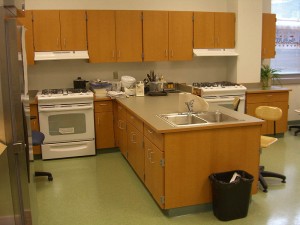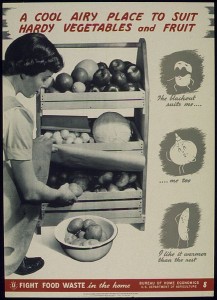Where should cooking be taught?

Does this look familiar? (Home Economics classroom on the third floor of Union City High School in Union City, New Jersey.) Creative Commons photo by Nightscream, some rights reserved.
Last week’s post on a free cookbook for low-cost meals included a manifesto-like quote from an important food thinker, Michael Pollan:
“Cooking is probably the most important thing you can do to improve your diet. What matters most is not any particular nutrient, or even any particular food: it’s the act of cooking itself. People who cook eat a healthier diet without giving it a thought. It’s the collapse of home cooking that led directly to the obesity epidemic.”
One could dismiss that as just so-much self-promotion for Cooked, one of Pollan’s many books about food, nutrition and health.
But let’s presuppose agreement. That home cooking saves money and produces better nutritional outcomes. Its decline is hurting the nation’s health. If so, what’s the best way to revive a depressed skill?
Well, here in Canada the Ontario Home Economics Association (OHEA) is campaigning to have Ontario schools require at least one course on food and nutrition, which would presumably include attention to home cooking. As quoted by this CBC article:
“We think that all children need to have the basics of nutrition and some cooking skills so that they know how to make food from scratch and don’t reach out so often for fast food or prepared entrees or mixes and other items that are so readily available in our stores,” said professional home economist Mary Carver.
“We can see the decline in health in Canadians in general, particularly children, there’s a great rise in childhood obesity… a rise in type 2 diabetes, a rise in high blood pressure and cardiac disease in adults. All of these are lifestyle and diet-related issues and they put a huge strain on our healthcare system.”

WW II era poster on efficient storage of food. Source: National Archives and Records Administration
A petition drive is underway to make that a new graduation requirement.
The funny part is schools used to require even broader coverage of life skills under the umbrella of home economics. Which used to be mandatory material – for girls.
My own mini-activism at Baldwin High in the mid 70s included a fight for the right to take shop instead of stodgy “home ec.” The principal was only willing to offer a compromise, in which I could take two electives instead: family foods and family clothing. Those were co-ed courses taught with amazing enthusiasm by a real character. Mrs. Ota understood local culture and her students very well: people in Hawaii (people everywhere) like to grind (eat).
We whipped up important ethnic mainstays. Stir fries, pancit, lap cheong bao (bao = Chinese buns, usually with savory or sweet filling), crispy wonton, adobo. Bagoong and patis were even demystified. (Fermented fish sauce become trendy with the urban popularity of Thai food. But the smelly backbone of humble Filipino cuisine was then the object of general derision.)
Mind you, local food in Hawaii at that time earned sharp criticism on the nutritional front. (The stereotype about southern cooking is that everything is deep fried. The rap on Hawaii food is that it tends to feature too much fat, white rice and shoyu.)
Setting memory lane and nutritional shortfalls aside, where should healthful cooking be taught? Ideally, we’d all be learning home cooking at home, from Grandma, Uncle Frank, Mom and Dad.
The trouble is, that doesn’t always happen. Whole generations are growing up in homes where scratch cooking is a rare thing.
School seems like a sensible place to convey basics. The trouble is, cooking is just one of many life-skills worth teaching. One could add other vanishing subjects, like consumer finance and budgeting, simple home repairs and basic auto maintenance. Not to mention new skills, like computer use and programming. All of that – plus lots of P.E., classes for learning trades and/or college track content, music, art and foreign languages – would be available at perfect schools. Served by great teachers with unlimited budgets, and no competition for instructional time…as seen on planet “in your dreams”.
Also, would one course on food, nutrition and cooking be enough to cover so much material? How are the bitter battles about what’s healthy going to be settled? (The meat and dairy industry verses the crowd that says it’s healthier to eat little or none of those things?) Where would the money come from, for kitchens and enough food to do real cooking?
But I’m not done with the questions, because I’m endlessly curious. Do you think cooking should be taught in schools as part of required curriculum? Who taught you to cook? Where are young people today learning that skill?
NCPR has done stories on regional efforts to take scratch cooking even farther, with schools that grow their own gardens to cook and eat together. Or the example of a carrot tasting contest at Long Lake Central School, which teacher Becky Pelton called “…probably the most rewarding, the greatest learning experience I’ve had since we’ve had the garden”
The garden-to-plate model seems ideal. But that level of engagement is really hard to pull off without strong support and some degree of autonomy.
Kudos to the schools that are already doing that. And to the homes where cooking is still practiced.
Tags: canada, cooking, education, food, gardening, health, home economics, nutrition








Lots of kids love to cook. Some learn at home; some learn at school; some learn through church youth groups; some learn through other clubs and organizations. The most important thing I have learned about helping youth appreciate grower-to-plate is that it takes the support of whole communities. Children and families need to know that real food exists outside of a fast food bag or frozen food box. They need guidance to choose whole foods even when those choices seem strange at first. They need a working kitchen with mixing bowls, knives, cutting boards, and a pan big enough to do more than warm up canned soup.
The Health Initiative has been encouraging youth cooking, and it takes a whole lot of support from teachers, parents, school food service staff, local businesses, food producers, and local media (Yay NCPR!).
Check out the videos and info at ncjrironchef.org
Cooking is far more useful than some of the other things I learned in school, like parts of speech trees and calculating a square root by hand (which I never used even as a pursued a math degree in college).